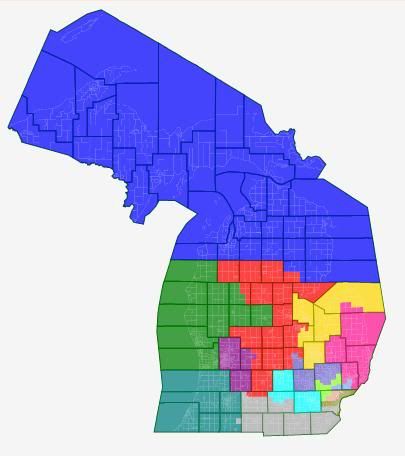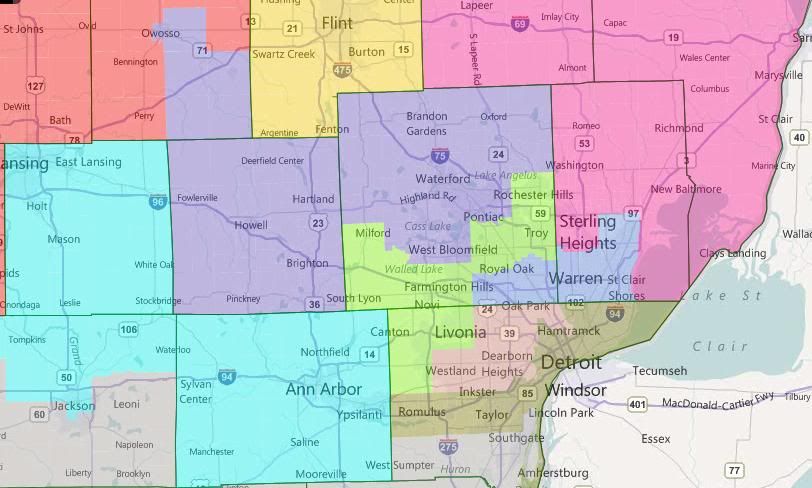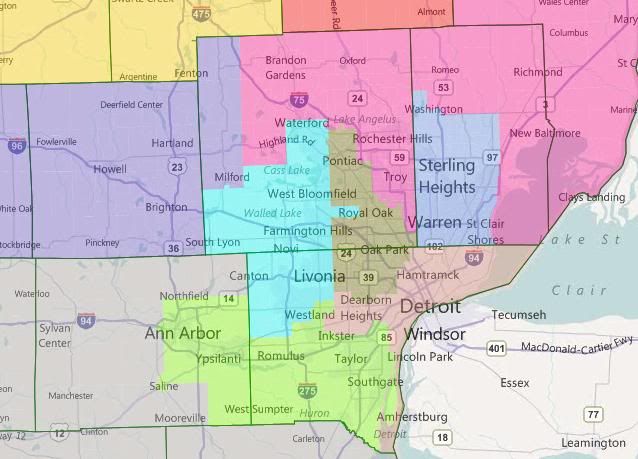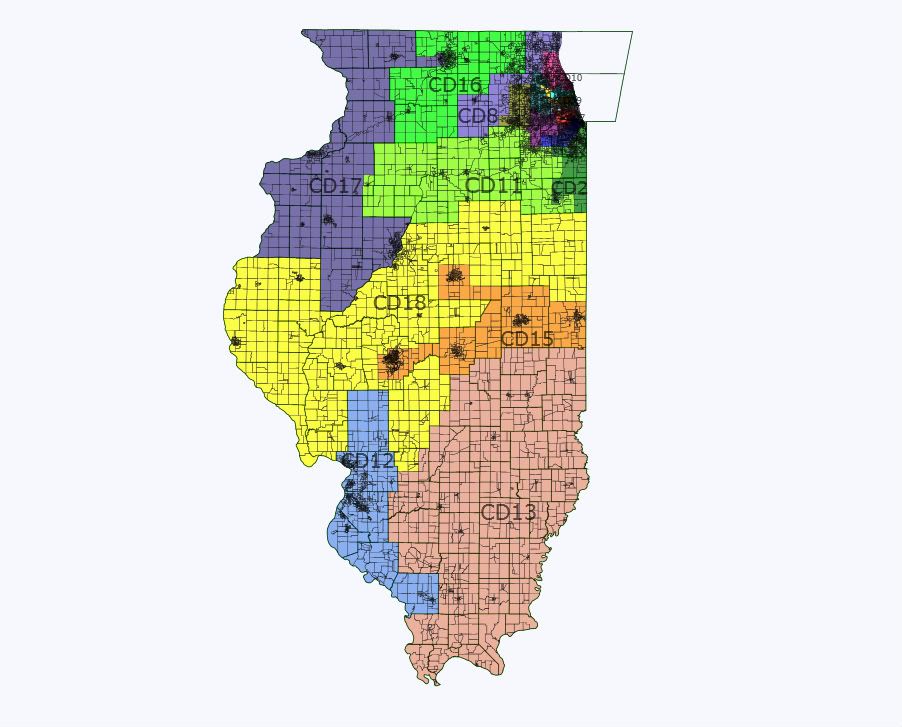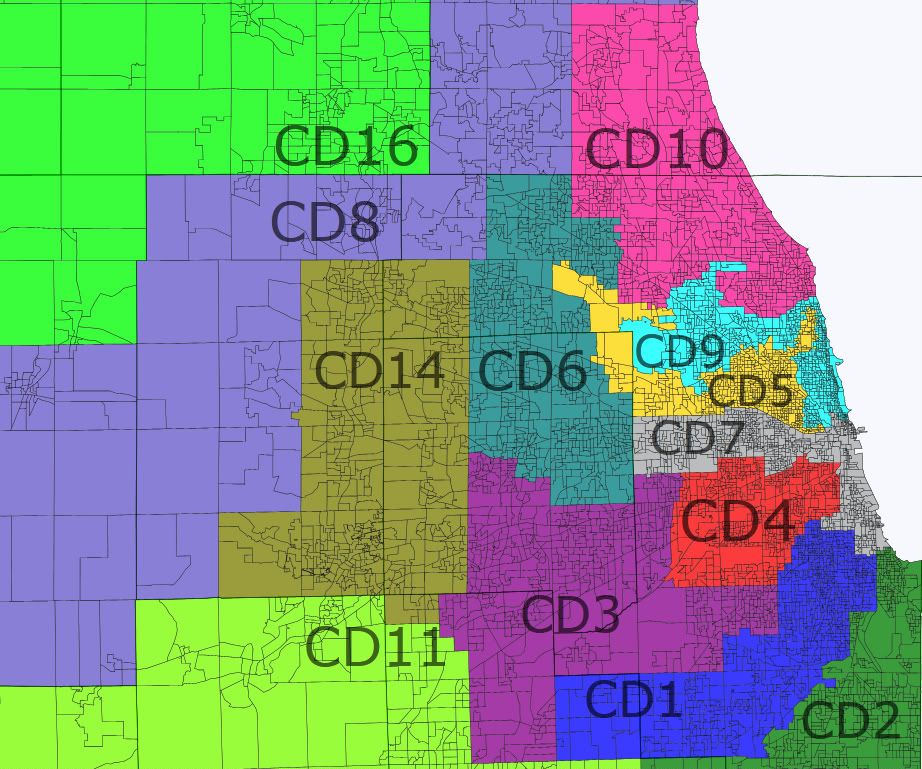Now that the Census numbers are out and the Maryland prison population has been “reallocated” in accordance with a new law here (well, mostly reallocated — http://planning.maryland.gov/P… ….) I wanted to do a diary showing how Democrats can still be added to the Maryland Legislature despite the fact that Baltimore City is set to lose one district to the more Republican northeastern part of the state. This map is also done in a manner where there are as few county splits as possible and I likewise tried to keep communities within counties in the same district.
I only drew districts for areas outside Montgomery and Prince George’s Counties and Baltimore City. Those three jurisdictions are hyper-Democratic (combined vote 81.2 Obama – 17.7 McCain) and should have no trouble electing only Democrats. The only trick there will be to balance the interests of the incumbent Democrats and the interests of minority communities.
Maryland’s Legislative redistricting should actually be quite easy this time around. Due to a random mathematical quirk, a very large proportion of counties and regions of the state can be redrawn whereby very few districts need to cross county lines. I made most of my new districts have a population deviation of +/- 3.5% (although most are +/- 2.5%), which is better than the +/- 5% deviation that has been used in the past. (A few of the sub-districts here deviate up to +/- 4.5%.) I have also made the new districts reflect the population adjustments required by a new Maryland law that reassigns the prison population from place of incarceration to last known address — http://planning.maryland.gov/P…
You can see what I mean below:
The ideal district population this time around is 122,813 (for sub-districts it equates to 81,875 and/or 40,938).
– Baltimore City corresponds to exactly 5 districts with 125,333 persons each (2.1% above ideal).
– Montgomery Co. corresponds to exactly 8 districts with 121,542 persons each (1.0% below ideal).
– Prince George’s Co. corresponds to exactly 7 districts with 123,589 persons each (0.6% above ideal).
– Harford Co. corresponds to exactly 2 districts with 122,697 persons each (0.1 % below ideal).
– Frederick Co. and the three western Maryland counties correspond to exactly 4 districts with 119,727 persons each (2.5% below ideal).
– Baltimore and Carroll Counties together correspond to exactly 8 districts with 121,744 persons each (0.9% below ideal).
– Charles and St. Mary’s Counties together correspond to exactly 2 districts with 126,073 persons each (2.7% above ideal).
– Cecil and Kent Counties together correspond to exactly 1 district with 121,553 persons (1.0% below ideal).
– The lower Eastern Shore (5 counties including Caroline) corresponds to exactly 2 districts with 120,223 persons each (2.1% below ideal).
At this point, what’s left is only Calvert, Anne Arundel and Howard Counties on the western shore and Talbot and Queen Anne’s on the eastern shore. Crossing as few county lines as possible was the reason why I drew a district across the Bay Bridge linking Talbot and Queen Anne’s with the Broadneck Peninsula in Anne Arundel (one of the eastern shore districts has to cross somewhere, so why not here). Anne Arundel still has 4 districts that are all or mostly in the county, while 2 more cross over with Calvert and Howard. Howard itself has 2 that are completely within the county. I drew separate sub-districts for those parts of Anne Arundel shared with Howard, Calvert and the Eastern Shore.
The main way I get more Democrats is the following two major changes:
1.) In Howard, the new District 9 becomes a whole lot more Democratic — new district is 60.1 Obama – 38.0 McCain — while the current district is only around 43 Obama.
2.) In Anne Arundel the new District 31 becomes a whole lot more Democratic — new 53.7 Obama – 44.3 McCain (but the Democratic 2006-2008 partisan numbers look even better there: 57.9 Dem. – 42.1 GOP) — while the current district is only around 40 Obama.
Here’s the map:
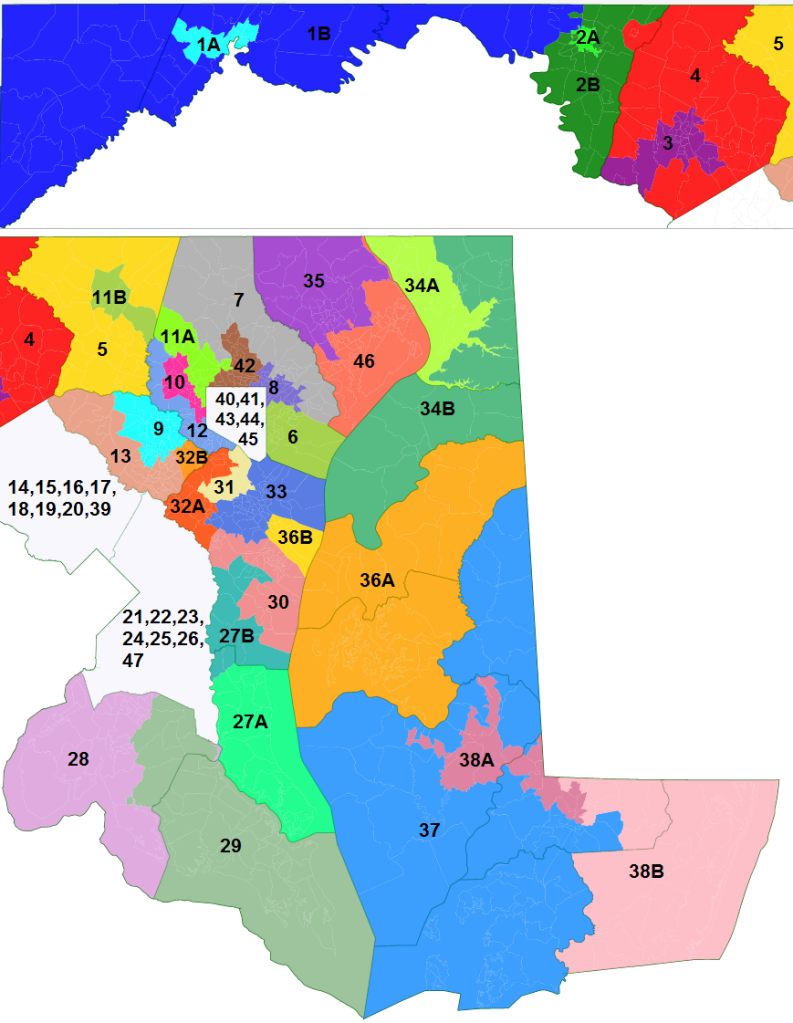
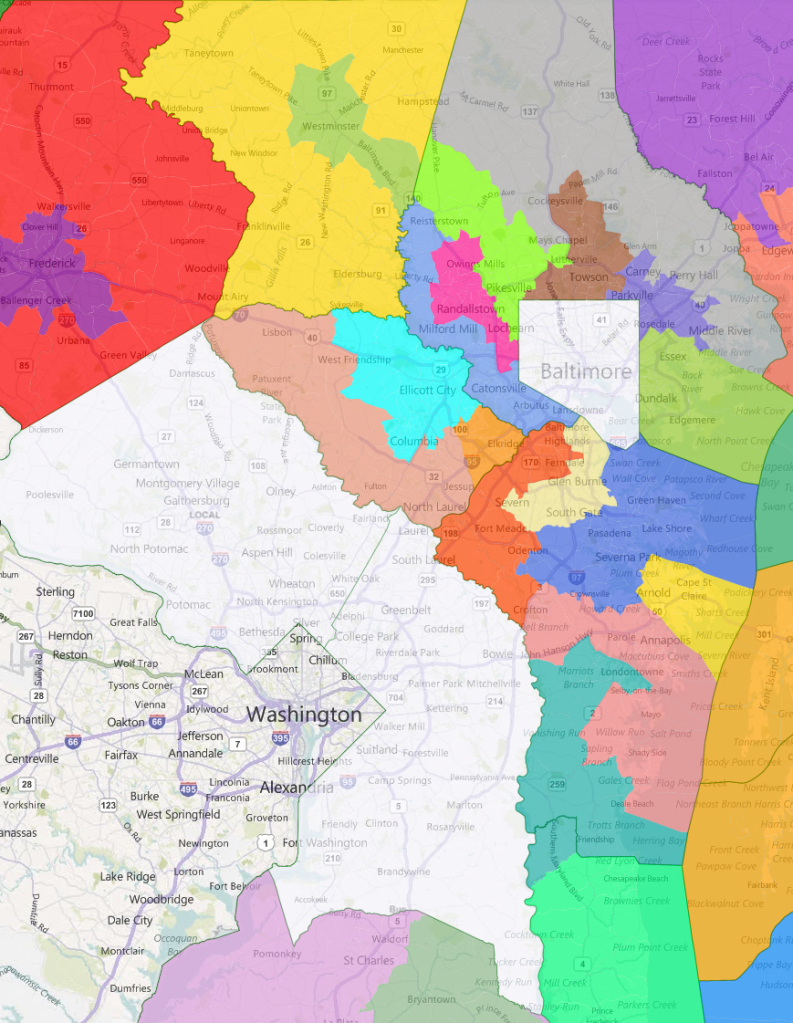
As I’ve said before, I didn’t even mess with Montgomery, Prince George’s and Baltimore City for the purpose of this diary which is to show how to draw the lines so more Democrats are elected — those three combined will have 20 Democratic Senators and 60 Democratic Delegates. The lines can easily be drawn where all 5 Baltimore City districts are 60%+ African-American, and the Maryland suburban districts can likewise be drawn to reflect the great ethnic and racial diversity there.
Virtually all other existing Democratic districts remain roughly at the same Democratic percentage or better. Basically, to improve Democratic chances, I made the Dem-held districts more Democratic while making the GOP-held ones even more Republican, while still adding the two new Democratic seats discussed above.
The suburban districts in Baltimore Co. are all redrawn whereby the 6 districts going clock-wise around Baltimore City will all elect as many Democrats as possible (all the Republicans are packed into District 7 in the northern and eastern extremity of the county).
There is one district where the Democratic percentage would decline by a lot – District 27 which is the home of Senate Leader Mike Miller. The new 27th would no longer have southern Prince George’s to make it more Democratic, but on the flip side, Miller would no longer need to fear a black primary challenger while his district would remain at 50.0 Dem – 50.0 GOP (2006-2008 partisan aggregate) – enough for him to win the general, as his “conserva-Dem” persona would fit the Calvert-based district perfectly.
Now to brief discussion of individual districts:
Western Maryland and Frederick Co.
District 1 – remains GOP, 65.3 McCain, 32.7 Obama
Sub-district 1A – 1 Delegate, Cumberland and Frostburg, made to be more Democratic, 55.6 McCain, 42.0 Obama (current sub-district is only about 34 Obama)
Sub-district 1B – 2 Delegates, 69.6 McCain, 28.5 Obama
District 2 – remains GOP, 53.4 McCain, 44.7 Obama
Sub-district 2A – 1 Delegate, Hagerstown, 56.5 Obama, 41.4 McCain (same as current sub-district)
Sub-district 2B – 2 Delegates, 57.6 McCain, 40.5 Obama
District 3 – made more Democratic, 56.5 Obama, 41.8 McCain (current district is about 54 Obama), sub-districts eliminated so that all 3 Delegates can now be Democrats
District 4 – remains GOP, 58.3 McCain, 39.9 Obama
Baltimore Co. and Carroll Co.
District 5 – remains GOP, 65.7 McCain, 31.6 Obama
District 6 – remains the “conserva-Dem” district that it is, 52.7 McCain, 44.7 Obama (BUT, 58.0 Dem – 42.0 GOP avg. 2006-2008), which is same as current district.
District 7 – remains GOP, 62.3 McCain, 35.1 Obama
District 8 – made to be more Democratic in order to add Delegates here, 52.2 Obama, 45.4 McCain (current district is around 48 Obama)
District 10 – new district is 69.1% black, 88.0 Obama, 11.1 McCain
District 11 – remains Democratic, 55.5 Obama, 42.6 McCain (but 59.3 Dem – 40.7 GOP avg. 2006-2008), less Democratic than current but should be plenty safe here
Sub-district 11A – 2 Delegates mostly Jewish areas in northwestern Baltimore Co., 62.4 Obama, 35.9 McCain
Sub-district 11B – 1 Delegate, Westminster area in Carroll Co., 60.9 McCain, 36.6 Obama, this is really a bone thrown to the GOP as District 11 could be left without sub-districts and would then elect 3 Democratic Delegates
District 12 – remains Democratic, 59.4 Obama, 38.3 McCain (slightly more Democratic than current)
District 42 – remains as is, Democratic Senator here now should be OK, hopefully a few more Democratic Delegates are added; the elections here have been very close in recent past, 53.0 Obama, 44.6 McCain (same as current district)
Howard County
District 9 – made to be much more Democratic, 60.1 Obama, 38.0 McCain. Current district is only around 43 Obama so Democratic Senator and 3 Democratic Delegates are added !
District 13 – remains Democratic, 60.4 Obama, 37.9 McCain (somewhat less Democratic than current, but should still be very safe)
Anne Arundel County
District 30 – remains Democratic, 53.0 Obama, 45.4 McCain (a bit more Democratic than current, so hopefully the lone GOP Delegate will be ousted)
District 31 – made to be much more Democratic, 53.7 Obama, 44.3 McCain (but 57.9 Dem – 42.1 GOP avg. 2006-2008). Current district is only around 40 Obama so Democratic Senator and 3 Democratic Delegates are added ! (and bye, bye to the odious Don Dwyer). Most of the Democrats who now represent District 32 could really run here, as much of the territory in the current 32 becomes part of the new 31; I could have just flipped the numbering here … For the first time in decades Glen Burnie would now all be in one district.
District 32 – remains Democratic, 55.3 Obama, 42.7 McCain (slightly more Democratic than current)
Sub-district 32A – 2 Delegates, Anne Arundel Co., 55.8 Obama, 42.3 McCain
Sub-district 32B – 1 Delegate, Howard Co., 54.3 Obama, 43.5 McCain
District 33 – remains GOP, 60.9 McCain, 37.0 Obama
Southern Maryland
District 27 – drawn for Senate Leader Mike Miller, 54.2 McCain, 44.2 Obama (but exactly 50.0-50.0 Dem/GOP avg. 2006-2008, with exactly 10 more votes for the Dems !) – current district is ofcourse a whole lot more Democratic as it goes into Prince George’s but in order to preserve the little or no county splitting goal, this is the only way to draw here. As I mentioned above, Miller may not be against drawing the lines this way.
Sub-district 27A – 2 Delegates, Calvert Co. (except Dunkirk), 52.2 McCain, 46.2 Obama (but 51.9 Dem – 48.1 GOP avg. 2006-2008), would continue to be a swing area as currently
Sub-district 27B – 1 Delegate, Anne Arundel Co. (and Dunkirk in Calvert), 58.0 McCain, 40.3 Obama
District 28 – remains Democratic, 67.8 Obama, 31.3 McCain, new district is 44.5 white, 43.6 black
District 29 – remains the conserva-Dem swing area that it currently is, 55.5 McCain, 43.1 Obama (but 51.2 Dem – 48.8 GOP avg. 2006-2008) – about the same as current
Harford County
District 35 – remains GOP, 67.0 McCain, 30.4 Obama
District 46 – this district is “moved” here from Baltimore City, 50.0 Obama, 47.9 McCain (but 53.8 Dem – 46.2 GOP avg. 2006-2008), so should be a lean-Democratic district
Eastern Shore
District 34 – GOP Senator would remain, 55.1 McCain, 42.7 Obama
Sub-district 34A – 1 Delegate, 62.3 McCain, 35.3 Obama
Sub-district 34B – 2 Delegates, 51.4 McCain, 46.6 Obama (but 49.5 Dem – 50.5 GOP avg. 2006-2008), so area would be competitive
District 36 – remains GOP, 56.9 McCain, 41.4 Obama
Sub-district 36A – 2 Delegates, Queen Anne’s and Talbot Counties, 59.3 McCain, 39.2 Obama
Sub-district 36B – 1 Delegate, Anne Arundel Co. – Broadneck peninsula (Arnold and Cape St. Claire), 52.6 McCain, 45.4 Obama
District 37 – remains GOP, 59.2 McCain, 39.3 Obama
District 38 – reconfigured to shore up newly-elected Democratic Senator here, 50.4 McCain, 48.3 Obama (current district is only about 41 Obama)
Sub-district 38A – 1 Delegate, majority-black, 68.5 Obama, 30.3 McCain
Sub-district 38B – 2 Delegates, 58.3 McCain, 40.4 Obama



